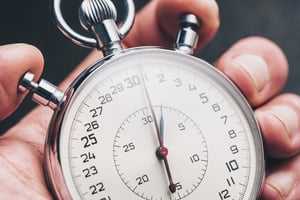
The digital era has introduced massive changes to the sales process. In previous decades, buyers were fine with sellers proactively engaging them and presenting the selling points of a product; but today, the modern buyer likes to initiate contact and enjoys feeling in control of each step in the process, from the point of contact to the point of sale.
According to Forrester Research, 56 percent of business-to-business buyers want to self-educate about products and services. When they need something, these buyers would rather go out to the Internet to find the information themselves, instead of having a stranger come to them pitching a product or service. Also, 65 percent of B2B sellers report that buyers prefer online ordering, rather than interacting with a representative over the phone or in person.
 And yet, a buyer’s expectations for how the sales process should unfold is more stringent than ever. Buyers expect a sales process that works for them, according to their specific timeline. In this regard, speed-to-lead, the timing and cadence of sales followup to a new lead, is more important than ever.
And yet, a buyer’s expectations for how the sales process should unfold is more stringent than ever. Buyers expect a sales process that works for them, according to their specific timeline. In this regard, speed-to-lead, the timing and cadence of sales followup to a new lead, is more important than ever.
What does that mean for sales professionals? For a sales rep, timing becomes crucial. Engage too soon, and you risk annoying or scaring off the interested buyer. However, if you wait too long after a lead has made contact, the buyer will grow impatient and move on. After all, the buyer has already done the research on their own; and when they finally make contact, they expect your company’s immediate attention, or they’ll go elsewhere. The buyer holds the power; and the first vendor to respond on their terms will win the sale.
As a result of changes in the marketplace, Forrester’s study states that companies are swapping out 39% of traditional sales representatives with inside sales reps. These individuals specialize in knowing exactly when to jump on a hot lead with targeted personal interaction. For them, “speed-to-lead” is the key.
Data is your best friend when it comes to figuring out how and when to contact potential clients. As such, it’s essential to stay abreast of new studies and information pertaining to sales best practices that will help shed light on why you may not be seeing the best outcomes with your sales processes.
Back in 2011, InsideSales.com did a study on Lead Response Management. In that report, the authors stressed the importance of immediate follow-up with hot leads, suggesting that reps call their prospects within the first five minutes. They determined that when the buyer completed a lead form, an available rep should make a call within a few minutes.
However, in 2017, preliminary results of new research from the Telfer School of Management at the University of Ottawa were released. This study, the full results of which will be released in the second half of 2018, analyzed 130 million interactions with 45,000,000 distinct contacts, including 4 million web leads. The results of this study call into question what was found in the InsideSales.com research.
A sales call within the first five minutes of contact seems too fast; unless, of course, the lead specifically says, “Call me!” It can actually turn off and scare the buyer away. Sales development representatives (SDRs) have better success and more positive interactions when they call within a specific time window— 10-60 minutes after the first contact from a warm lead. The Telfer study authors explain that “win outcomes were three times more likely when contact was made in the 10 to 60-minute time frame than in the first 10 minutes or after one hour.”
 Sarah is looking into a particular data management service for her company. She has done the research and is interested in one specific vendor, so she fills out a form on the vendor’s website. Then she moves on to another unrelated task in her workday.
Sarah is looking into a particular data management service for her company. She has done the research and is interested in one specific vendor, so she fills out a form on the vendor’s website. Then she moves on to another unrelated task in her workday.
If the vendor were to call her within two minutes, Sarah might feel rushed or pressured. She may not have had time to open the white paper or ebook she downloaded from the website. However, if she receives a call 20 minutes later, she will be more likely to react in a positive way to the call. The information she gleaned and her thoughts about this vendor are still fresh in her mind, but she’s had a little space and time to think since filling out the form. To her, the vendor is considerate and prompt without seemingly overly desperate for her business.
What happens if the vendor were to wait to contact Sarah until 24 hours or more had passed? The research is clear— sales engagement drops significantly after several hours, and even more so after a day or two. The Telfer study shows that contact within the 20-60 minute range has a 14 percent positive response rate. After 24 hours, it plunges to just 5 percent. So if no one contacts Sarah in a reasonable amount of time, she would likely move on to another vendor— one that shows an active interest in her company’s needs.
Unfortunately for most businesses, sales development reps just aren’t calling fast enough. The average SDR response time, according to an AA-ISP Lead Study, is 38 hours.
Other studies also show that response times are usually more than 40 hours from the time of the first contact. According to a HubSpot article by Chris Getman, only 37 percent of companies respond to their leads within an hour. Considering how the modern buyer thinks, it’s clear why SDRs experience little success from their calls— they have waited too long. Their buyers are interested in a quick response; and do not like when they are forced to wait.
Think of the old children’s story of Goldilocks and the three bears. Goldilocks rejected the porridge when it was too hot or too cold; she was looking for a bowlful that was just right. In the same way, a sales team’s response times may be too fast or too slow. The trick is to time them just right; optimal first contact should occur between ten and 60 minutes after the lead was captured.
“Speed to lead” is, quite simply, how fast your sales reps get to the potential buyer after the first contact. The ideal response time window of 10-60 minutes is admittedly tight. You may be thinking, “How in the world can we do this? It’s impossible to achieve that precise of a response time on a regular basis!” It seems tough, but there are strategies and sales engagement tools you can implement to make it happen.
 There’s one quick, effective way to check your company’s response time, according to Chris Getman. You can secretly shop on your company’s website as a mystery shopper, using fake customer profile data, and request a quote for a product or service. See how long it takes your sales reps to get back to you. Do they respond via phone, email, or both? Don’t answer the first call or email— see how much time elapses before your team follows up again. How many times do they try to get in contact?
There’s one quick, effective way to check your company’s response time, according to Chris Getman. You can secretly shop on your company’s website as a mystery shopper, using fake customer profile data, and request a quote for a product or service. See how long it takes your sales reps to get back to you. Do they respond via phone, email, or both? Don’t answer the first call or email— see how much time elapses before your team follows up again. How many times do they try to get in contact?
With the help of a friend or family member, test the response time and follow-up frequency again a couple of times using different phone numbers and email addresses. Assemble the results, and use that baseline data to start the discussion with your team.
 Now that you have the data, you need to step back and take a hard look at your current process. Your team isn’t responding to leads quickly enough— why? What obstacles are preventing them from achieving those quick response times?
Now that you have the data, you need to step back and take a hard look at your current process. Your team isn’t responding to leads quickly enough— why? What obstacles are preventing them from achieving those quick response times?
Do your SDRs immediately know when there is a hot lead? How are they informed about new prospects? You may have a system miscommunication issue— systems that don’t talk to each other or take a long time to sync or don’t integrate smoothly. If your CRM and marketing automation don’t work with other company systems, your people may be doing extra work to bridge the gap; and those additional tasks are stealing them away from their primary duty— contacting warm leads.
Maybe your sales development reps spend too much time processing orders. Perhaps you could have a sales administrator or two handle that part of the process, freeing up your SDRs for more important duties like quickly responding to prospects.
As the sales manager, do you touch every lead, evaluate it, and pass it on to specific reps? Precious minutes slip away while you and your team perform those distribution-related tasks. Why not use automation software instead? There are highly specialized pieces in a sales engagement solution that can divvy up the leads according to priority and other factors.
By reorganizing the responsibilities of each team member and incorporating sophisticated sales technology, you can dramatically improve your team’s speed-to-lead. All it takes is a couple of meetings to rework your current priorities, plus an initial investment and some training in your new, streamlined, well-integrated sales engagement software.
While your SDRs may be fairly good at what they do, theyvmay not be up to date on the latest sales strategies andvinformation. They may also lack the tools necessary to do their work efficiently and per sales best practices.
It’s a good idea to have a refresher course every so often to ensure that your inside sales reps have the most current facts about what works with today’s customers. Without an occasional training session, team members settle into patterns or lazy habits that don’t help your business’s productivity or conversion rates.
 Newer members of the team may not be complacent; they may simply be insecure about their skills. Their lack of confidence triggers a reluctance to contact prospects and a failure to close when they finally get in touch with a lead. Do you have effective training programs in place for new hires? Perhaps beefing up those training programs could improve the success of your newbie SDRs. As they feel more confident and successful in their roles, their speed-to-lead and their call sessions will be faster, thus improving your department’s overall speed-to-lead.
Newer members of the team may not be complacent; they may simply be insecure about their skills. Their lack of confidence triggers a reluctance to contact prospects and a failure to close when they finally get in touch with a lead. Do you have effective training programs in place for new hires? Perhaps beefing up those training programs could improve the success of your newbie SDRs. As they feel more confident and successful in their roles, their speed-to-lead and their call sessions will be faster, thus improving your department’s overall speed-to-lead.
Another way of improving the confidence of new SDRs is to provide them with the right tools. Such a solution should provide your SDR team with logic-branch scripting that helps them confidently address objections, know which content to share on a call or email, and guide the conversation to qualify the opportunity. As you test different content pieces in this automated and guided sales engagement solution, you will learn the best eBooks, white papers, case studies or other content pieces that your SDRs can leverage at different points in the sales dialog.
An imperative feature your sales software should leverage is queue-based lead prioritization. In less sophisticated list-based CRM solutions, sales reps arbitrarily cherry-pick through their leads, prioritizing leads that they believe are most likely to close based on intangible attributes such as brand familiarity. This introduces potentially incorrect biases. To help your SDRs be successful, you should utilize a queue-based sales engagement platform that prioritizes lead follow up based on criteria you define for the team (geography, job title, industry, etc).
Along with the training, incorporate fresh details about your department’s expectations. Your SDRs need to know what timeframes you expect, and details around the agreed upon service level agreements (SLAs) between sales and marketing. As marketing invests money to create these leads, your SDR must follow up on leads appropriately and demonstrate to the marketing team that reps are pursuing a positive ROI.
 It’s up to you whether that communication occurs through emailed memos, new standard operating procedures (SOPs), posted guidelines at each workstation, or all three. Also, clarify differences in expectations for unique scenarios, such as leads from a trade show vs. leads from a web campaign. Have a strategy for each type of lead and make sure that the response times and expectations are clearly worded and constantly accessible for your SDRs. In particular, ensure that your SDRs are set up for the greatest chance of success by detailing speed-to-lead along each step of the sales funnel, whether it be email, phone, direct mail or some other method of outreach.
It’s up to you whether that communication occurs through emailed memos, new standard operating procedures (SOPs), posted guidelines at each workstation, or all three. Also, clarify differences in expectations for unique scenarios, such as leads from a trade show vs. leads from a web campaign. Have a strategy for each type of lead and make sure that the response times and expectations are clearly worded and constantly accessible for your SDRs. In particular, ensure that your SDRs are set up for the greatest chance of success by detailing speed-to-lead along each step of the sales funnel, whether it be email, phone, direct mail or some other method of outreach.
One major problem facing an inside sales department is lead accessibility. How do the leads come to your SDRs? How fast do they arrive, and how much time has elapsed before they reach your reps? You may need to sit down with the folks from your marketing department and discuss the importance of pushing leads through to your reps as quickly as possible. Without that conversation and cooperation, you may not be able to control your speedto- lead as much as you’d like.
It’s also vital to discuss the difference between a marketing qualified lead (MQL) and a sales qualified lead (SQL). Marketers debate the exact definitions of these types of leads; but what really matters is how your company defines them.
According to an article by Justin McGill for LinkedIn.com, a marketing qualified lead is “a lead judged more likely to become a customer compared to other leads based on lead intelligence, often informed by closed-loop analytics.” A marketing qualified lead fits certain criteria and is more likely to become a promising sales lead than other individuals. Think of it as a “suspect” rather than a prospect.
A sales qualified lead is someone who is approaching the point of purchase. They aren’t just zooming through your website or blog because they’re bored; they are seriously considering your product or service. TechTarget.com defines SQL as:
“a prospective customer that has been researched and vetted— first by an organization’s marketing department and then by its sales team— and is deemed ready for the next stage in the sales process.... [it’s] a prospect that has gone past the engagement stage and is ready to be pursued for conversion into a full-fledged customer.”
Your precise definition of MQL vs. SQL may vary from this, but the important thing is that it matches your marketing department’s definition. That way, you can be sure that Marketing will pass those people to your team the instant they turn from MQL to SQL, from suspect to prospect.
Did you know that customer relationship management (CRM) is often the biggest impediment to speed-tolead improvement? Which pieces of software might be interfering with your speed-to-lead goals?
Many sales organizations use a less agile, list-based CRM system. With a list-based system, the sales reps are shown a list of leads to follow up with. That list could be 30, 50, or perhaps even 200 contacts long. What do the reps do? They do their best to determine which leads are going to go somewhere, and cherry pick those for full follow up while leaving the others to a sub-par follow-up timing and cadence. These reps, often with the best of intentions, self-direct their work as they see fit. The problem is, sales reps face artificial biases just as anyone would. They are arbitrarily prioritizing leads, and worse yet, deprioritizing others that may actually be better quality.
A queue-based sales engagement solution takes a fresh approach that ensures all leads are followed up on promptly and persistently. This kind of system prioritizes lead follow-up based on user-defined criteria (age, geography, job title, company size, industry, etc) and presents the SDR with the next best lead to call. There is no list — it’s a queue of leads provided to the SDR one prioritized lead at a time. No more cherry picking certain leads while neglecting others.

Further, a list-based system lacks the built-in guidance to focus SDR follow up and leaves too much room for distractions, such as over-researching information about a lead. With a queue-based sales engagement solution, the system guides reps through the follow-up process, ensuring they live up to SLAs and follow internal sales best practices.
There are many reasons why queue-based systems are better for speed-to-lead. Many organizations are finding their own optimal speed-to-lead improvements as they put a queue-based sales engagement platform between their marketing automation tool and their CRM tool, ensuring that only SQLs get into the CRM system and that the lists are more focused and workable.
 Think of this phase as digital house-cleaning. Your sales department may have accumulated software that just isn’t doing the job— it’s a hindrance, not a help. Maybe the software is too old, and it’s sitting there unused. Perhaps you invested in sales technology without doing your research, only to find that it doesn’t play well with your other systems and doesn’t perform tasks well enough or fast enough. You might be reluctant to clear out those pieces; after all, you paid good money for them and invested time in setting them up. Clear out the clutter and ditch the old tech that may be dragging your department down.
Think of this phase as digital house-cleaning. Your sales department may have accumulated software that just isn’t doing the job— it’s a hindrance, not a help. Maybe the software is too old, and it’s sitting there unused. Perhaps you invested in sales technology without doing your research, only to find that it doesn’t play well with your other systems and doesn’t perform tasks well enough or fast enough. You might be reluctant to clear out those pieces; after all, you paid good money for them and invested time in setting them up. Clear out the clutter and ditch the old tech that may be dragging your department down.
Look carefully at the way your reps interact with your current software— or better yet, test it on real prospects yourself! How many clicks does the rep need to make to disposition a lead? Too many clicks lead to frustration and slower response times, not to mention additional training requirements. Do the reps have to deal with Alt-Tabbing all the time, or do they have to switch between systems, losing valuable minutes? Your reps need something smooth, streamlined, fast, and easy to use.
As you shop for your next sales toolset, keep in mind several features that can significantly improve your speed-to-lead. You don’t need merely another piece of automation software; you need technology that genuinely engenders sales engagement.
 As you audit your process, assess your technology stack, and train your team, remember the reason you’re making the effort. There’s a direct correlation between your speed-to-lead and your department’s sales numbers and productivity. If you reach a recently generated lead within the target window of 10-60 minutes, you’ll have three times the likelihood of qualifying that lead. Once you’re outside that window, your chances of a successful sale or positive interaction drop significantly, down to just 8%, and then again to 5% after 24 hours. With those figures in mind, it’s easy to see how crucial speed-to-lead is to your sales success.
As you audit your process, assess your technology stack, and train your team, remember the reason you’re making the effort. There’s a direct correlation between your speed-to-lead and your department’s sales numbers and productivity. If you reach a recently generated lead within the target window of 10-60 minutes, you’ll have three times the likelihood of qualifying that lead. Once you’re outside that window, your chances of a successful sale or positive interaction drop significantly, down to just 8%, and then again to 5% after 24 hours. With those figures in mind, it’s easy to see how crucial speed-to-lead is to your sales success.
Keep in mind that persistence and customer experience is also a significant part of the equation. The Telfer research team’s findings revealed that “the average number of contact attempts needed for a positive outcome with a lead is 5.7 for B2B companies and 5.9 for B2C companies.” Of course, this can vary widely by industry or product or service. This means that your SDRs need to keep coming back to the potential customer at reasonable intervals to follow up, especially if they missed the ideal window.
The longer a rep keeps the prospect on the phone, positively engaging about the product or service, the better the chance of a win. According to the Telfer report, “for every increase of a minute in call duration, there is six times better odds of success with the lead.” Train your reps to be friendly, well-informed, and strategic in their conversations with potential customers, and you’ll see a better ROI as a result.
As a sales leader within your company, customer experience must be your priority. The 2017 report from E-Consultancy and Adobe Digital Trends reveals that customer experience will be the primary way that businesses differentiate themselves from their rivals moving forward. A considerable part of that customer experience is responsiveness— speaking to your leads when and how they want to hear you.
It’s time to invest in the most productive sales engagement software for sales development and inside sales teams, so you can focus your SDRs on engaging leads and growing
revenue. If you can master the art of the perfect customer experience by refining your speed-to-lead, you’ll do more than beat your competitors to a sale— you’ll exceed buyer expectations and build a new audience of satisfied customers.
Want to hear what other sales professionals have to say when it comes to speed-to-lead? Get your on-demand copy of the Speed-To-Lead webinar on Tailoring Customer Experience to the Digital Age.
I am extremely impressed with how easy it was to get started and train my marketers on the VanillaSoft solution. As well, I had a lot of flexibility on how I wanted this program to run for our company. Plus, customer service is EXCELLENT at VanillaSoft. I highly recommend VanillaSoft to anyone!

Jody Weinberg J Telecommunications
We have never been so successful. Since we started using VanillaSoft we have increased productivity by 175%! Also, working with the VanillaSoft team has been an incredible experience. They helped us customized our campaigns and page layout to fit our unique needs.

Lauren E. Siegel Hillel Michigan